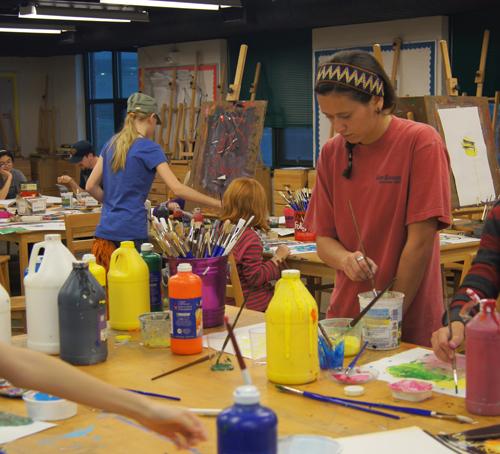 In 1994 in Fort William, Scotland, a group of children at a low-income school raised their own funds in order to pay for their art teacher to continue teaching them, as well as cover the costs of the studio and supplies they needed to create art. The children’s self-governed group was run like a business under the name Room 13.
In 1994 in Fort William, Scotland, a group of children at a low-income school raised their own funds in order to pay for their art teacher to continue teaching them, as well as cover the costs of the studio and supplies they needed to create art. The children’s self-governed group was run like a business under the name Room 13.
Vicky Grube, after reading an article about this initial children’s studio, hopped a plane to Scotland to observe it in action, bringing back these practices to Boone and starting her own Room 13 for children through Appalachian State University three years ago.
“I thought, ‘This is how everyone should be making things,’” Grube, the overseeing instructor for the group, said. “I really felt that it was important for children to be able to make their own inventions because so much learning happens when you can figure something out on your own.”
She described the workshops in Boone as an “instant success.”
The weekly workshops are sponsored by the Department of Art at Appalachian and take place in the classrooms of the Turchin Center, where children ages six to 12 are free to experiment with the materials they have access to.
Stations are set up with materials ranging from the usual paints, yarn and cardboard to recycled insulation and bottle caps, and for the two hours they are there, the children are allowed to run wild and take home their creations afterward.
A unique aspect of this workshop is that it involves art education majors. Aside from setting up stations, instructing proper use of materials and supervising the use of tools, Appalachian students offer their artistic advice to children who seek it, bouncing ideas off of each other and facilitating the use and access to whatever materials the children may need.
“It allows us to get experience working with the students and it lets us know the practices and we see how they’re learning through the study of the materials,” Gavin Murray, art education major and volunteer at Room 13, said. “I believe it better prepares us for a job of working with children, especially in education because we find a way to make them interested in learning.”
“I think it’s important, even if we might have to end up running a class differently than this,” junior art education major Skylar McGhee said. “It’s important to see the spectrum of what kids can do with independence.”
Grube believes that sometimes the least traditional methods of creating art are the most inspiring to children.
“If you give an 8-year-old girl a saw to cut a door for her kitty house out of a piece of cardboard, that really gives confidence,” Grube said. “They can solve a problem using this material and they don’t have to be frightened or worried that they’re not up to it.”
“I would tell people to come because I think it’s a good way to build their imagination and let them explore with whatever they can make,” Willow, age 12, said after participating in sponge and splatter painting. “I think it’s every kid’s dream.”
Room 13 meets every Wednesday from 2:30 to 4:30 p.m. in classroom 3200 of the Turchin Center for the visual arts. The workshops are open to children ages six to 12. To register contact Vickie Grube at grubev@appstate.edu.
Story: LOVEY COOPER, A&E Reporter
Photo: Amy Kwiatkowski

